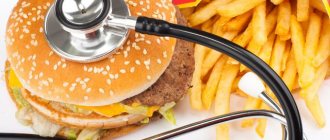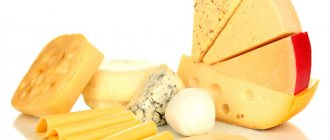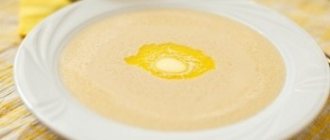Everyone knows about the beneficial properties of red and black caviar, but not everyone knows that these delicacies contain a lot of cholesterol.
The reason for this is the large amount of animal fats found in any fish roe, but you should not completely abandon these products.
Indeed, thanks to their composition and a competent approach to consumption, red and black caviar will bring much more benefit to the body than harm.
Composition and benefits of red caviar for the body
The product contains a huge amount of all kinds of useful substances that are vital for the full functioning of the body. So, 100 g of product contains about 30% proteins, 20% fats and only 3-4% carbohydrates. This automatically includes it in the list of dietary foods (if consumed in moderation).
The composition includes many microelements and vitamins:
- folic acid;
- iodine;
- calcium;
- potassium;
- zinc;
- B vitamins;
- iron;
- phospholipids;
- magnesium;
- vitamins E, D, PP, A and K.
In addition, it contains unique Omega fatty acids (omega-3 and omega-6), which have a strong antioxidant and immunostimulating effect. Daily consumption of the product in minimal quantities can fully provide the body with all the necessary nutrients. Caviar not only strengthens the immune system, but also normalizes blood pressure, strengthens bones and joints, cleanses blood vessels, improves vision and stabilizes thyroid function.
Useful and healing properties
Red caviar is endowed with beneficial and healing properties in abundance, despite the fact that it is a salty product. If you consume this natural delicacy in reasonable quantities, red caviar will only bring benefits.
- Prevention of rickets due to the high content of vitamin D, which is often lacking in the body. If your child is rarely exposed to the sun, then the deficiency of the element will have to be replenished from food products, and salmon caviar is ideal for this. For a more economical option, you can use fish oil.
- Brain function improves and the nervous system is strengthened. Red caviar is rich in lecithin, which has a positive effect on brain function. And in combination with polyunsaturated fatty acids, memory, attentiveness and concentration improve.
- Red caviar saturates the body with energy thanks to its balanced composition of vitamins, as well as proteins and fats. This quality is most valuable for athletes and people who have recently undergone surgery or a serious illness.
- The delicacy is especially useful for men, since with regular use it improves potency, restores reproductive function and stimulates the release of sex hormones, acting as a natural aphrodisiac.
- High protein content. Protein from seafood is absorbed many times faster than protein of animal origin. A complete saturation of proteins is important not only for athletes, but also for every adult, since protein has a direct impact on the vital functions of the body.
- Immunity is strengthened. In winter, the immune system weakens, which leads to frequent illnesses, often due to a deficiency of useful elements, in particular iodine. 100 g of red caviar contains double the daily requirement of iodine required by an adult. In addition, a lack of useful minerals leads to weakness and apathy.
- Due to the high calcium content in red caviar, the bone skeleton is strengthened. This property is important not only for the younger generation, but also for older people. In old age, bones become more fragile, so the body simply needs an additional source of calcium.
- Red caviar has a positive effect on the functioning of the cardiovascular system. This happens due to an increase in the amount of hemoglobin in the blood. In addition, the product contains high levels of sodium, which dilates blood vessels and improves blood circulation. As a result, blood pressure is normalized and the likelihood of blood clots is reduced. Potassium, which is part of the chemical composition of caviar, strengthens the walls of blood vessels and has a positive effect on hematopoiesis.
- The condition of cell membranes improves due to the beneficial cholesterol included in the product.
- Red caviar is good for vision. Thanks to vitamin A, the delicacy can be used both as a preventive measure for eye diseases and as an auxiliary component during treatment.
- Red caviar is considered a means of preventing cancer thanks to the lysine included in the product. The effects of lysine are enhanced by vitamin C and fatty acids, which have antioxidant properties.
- The delicacy serves as a preventive measure for the development of diseases such as Alzheimer's disease, psoriasis, obesity, depression, asthma and eczema.
- The functioning of the thyroid gland is normalized due to the high iodine content.
The daily dose of red caviar should not exceed 70 g due to its high salt content. For good health, it is enough to eat 1 or 2 teaspoons of the product.
Important! Children are allowed to give red caviar no earlier than they reach the age of 3, since the product is considered difficult to digest.
© sharafmaksumov — stock.adobe.com
Does red caviar contain cholesterol?
There is quite a lot of cholesterol in red caviar, from 300 to 580 mg for every 100 grams of product, which is equal to or exceeds the maximum permitted daily intake. This concentration is due to the high percentage of animal fats.
However, most of the fats (up to 80%) are Omega-3 and other polyunsaturated acids. Thanks to them, the level of high-density lipids (HDL) increases, which contribute to the removal of LDL (“bad” cholesterol). Therefore, despite the high content of the component in the product, the level of “harmful” cholesterol in the body is significantly reduced.
Difference between LDL and HDL.
What is bad and good cholesterol
Fats contained in the human body are called lipids. They consist of cholesterol and triglycerides. Cholesterol is produced in the liver and intestines, but 20% comes from food. Before entering the bloodstream, it binds to proteins and, having received a new name lipoproteins, is carried through the blood throughout the body.
There are 2 types of lipoproteins. One low-density lipoprotein (LDL), known as “bad” cholesterol. Another type is high-density lipoprotein (HDL), which is commonly known as “good” cholesterol. In the human body, high-density lipoprotein HDL removes excess “bad” LDL from the body. When the liver malfunctions, the incorrect ratio of these compounds, combined with overall high cholesterol levels, leads to cardiovascular disease and impaired brain function.
If the concentration of cholesterol in the blood is higher than normal, this leads to the deposition of atherosclerotic plaques on the walls of blood vessels
“Bad” LDL forms atherosclerotic plaques, which are deposited on the inner wall of blood vessels. When fat metabolism is disrupted, plaques form in all vessels, but they pose the greatest danger in the coronary and cerebral vessels, where blood flow slows down around them and a blood clot forms.
The further fate of the blood clot is similar to a ball floating along a stream. Increasing, at some point the thrombus blocks the lumen of the vascular stream, and deprives the brain and heart tissue of blood.
The catastrophes are known as myocardial or cerebral infarction (stroke). In some cases, the plaque itself, increasing, blocks the flow of blood in the vessels of the heart and brain.
Triglycerides in lipids are a source of energy for the body. However, with excess dietary fat, additional triglycerides are produced. The higher the level of triglycerides in the blood, the greater the risk for a heart attack. The risk factor is aggravated by low levels of “good” HDL and high triglyceride levels.
Is it possible to eat red caviar if you have high cholesterol?
It is important to understand that this seafood is allowed for consumption with high cholesterol, but within reasonable limits. Caviar is widely used in folk medicine as a cure for most ailments. The proteins included in the composition are much more successfully absorbed by the body than any other proteins, and there are practically no carbohydrates in it. But at the same time, red caviar itself contains a lot of fat, and vegetable oil can be added to each jar.
Delicacy production
The technology for producing caviar is a fairly easy process. The eggs are freed from the membranes, passed through a special sieve to be sorted by diameter, and either covered with salt or filled with brine.
The best caviar is considered to be salted in July-August (spawning period). It is important to know that this product deteriorates extremely quickly. Salted fish eggs can “last” no more than 4 months, so all other products with a longer “life” contain preservatives. Usually these are E200 (sorbic acid), E239 (urotropine), E400 (glycerin) and antiseptics (but not more than 0.1%). Today this is the only way to allow humanity to enjoy the delicacy at any time of the year.
Daily norm
Many patients with elevated levels of harmful lipoproteins categorically refuse caviar. However, most experts believe that this product can be consumed not only with high cholesterol, but also with already developed atherosclerosis. Although in this case, you can use it no more than 2-3 times a week, 1-2 tbsp. l. in a day. With irregular, one-time use, even 4-5 tbsp will not affect cholesterol levels. l. or 40-60 gr.
A healthy person is allowed to eat such a delicacy daily, a tablespoon per day, which will provide a full daily dose of all nutrients and vitamins.
Exceeding the dosage can lead to disruption of lipid metabolism in the body. It is important to know that such a diet can compensate for the lack of microelements and fatty acids without any effort. That is why caviar remains an absolutely indispensable food product, both for healthy people and for patients with high cholesterol concentrations.
Harmful ingredient
Like all high-calorie foods, caviar and the cholesterol found in it require proper consumption. Sandwiches with butter and red caviar are a bad combination that increases cholesterol many times over, which is not recommended. The only harmful ingredient is salt. Considering the pickling process for long-term storage, the amount of consumption should be minimal. Increased salt concentration can be harmful in cases of arterial hypertension, coronary artery disease and kidney disease.
Correct usage
You can get the maximum benefit from eating this expensive delicacy by following just a few simple rules.
Firstly, you should eat it only with rye bread (with bran or whole grains), and in no case with wheat bread. Secondly, you should refuse sandwiches spread with butter, because animal fats contain a huge amount of LDL, which negatively affects the indicator.
You should buy the product only from trusted retail outlets, having previously studied the quality certificate and the composition of the product. If there are preservatives and dyes, then it is not advisable to buy it. Good caviar goes well with vegetable side dishes, light snacks and salads. In moderation, it can speed up metabolism, which is very helpful in the fight against excess weight.
Prohibited Products
The number of cholesterol molecules in the salmon delicacy is not so scary for the pathology of hypercholesterolemia when consumed normally, as well as during the period of an anti-cholesterol diet.
When on a diet to reduce cholesterol index, you should not eat the following foods:
- Products with trans fats . Avoid all products that contain margarine - baked goods, sauces and mayonnaise;
- Fats from dairy products - full-fat sour cream and cream, butter, processed cheese and hard cheeses;
- Do not eat shrimp, scallops, squid - they increase low-density cholesterol;
- Animal fats - lard and fatty meat, as well as meat by-products . Refuse processed meat - sausages, smoked meat cuts;
- You should also avoid canned meat and fish.
If the cholesterol index is normal, then you should not give up animal fat, but it is important to consume saturated fats in small quantities and with plenty of fresh vegetables, which will help the proper processing of lipids.
Possible harm and contraindications
In stores, eggs are sold in pickled form, which does not add any benefits to the body. A large percentage of salt added to such canned food can dramatically disrupt the salt balance, deteriorate blood composition, and cause oxygen starvation of internal organs. Here, people who live directly by the sea, where salmon caviar is mined, are more fortunate. They have every chance to eat exclusively fresh, high-quality products, without harmful additives.
Despite this, you cannot refuse this tasty delicacy, because even in canned form, it retains all its beneficial properties. The only absolute contraindications are allergies to seafood and individual sensitivity.
Where does “red gold” come from in Rus'?
Many will recall a scene from an old Soviet film, where one of the characters invites guests to the table with “red, black and overseas eggplant” caviar. The main paradox of the film is that no red caviar was known in Rus' during the time of Ivan the Terrible.
Content:
- Where does “red gold” come from in Rus'?
- What is caviar
- Varieties of red caviar
- Delicacy production
- The nutritional value
- Benefits for the body
- Dangerous properties of salmon caviar
- "Red gold" for beauty
- How to store the delicacy
- How to eat properly
This product first appeared on the royal tables at least a century and a half after his death - at the end of the 17th century, only after roads to Siberia were built. By the way, the first shipments of “red gold” brought by merchants to St. Petersburg did not arouse any interest. Merchants gave their goods to the poorest taverns for practically nothing.
Residents of the Far East had a completely different attitude towards red caviar. There the product remained in high esteem at all times. For the peoples of the north, fish eggs served as second bread. Fishing families consumed this tasty, nutritious and very healthy food in fresh, boiled, fried and dried form. But the salted caviar we are accustomed to appeared only in the first decade of the twentieth century. As soon as someone thought of treating the product with a salt solution, it instantly gained popularity throughout Russia. Salmon eggs became a truly royal dish only under Nicholas II. At the same time, demand for chum salmon and pink salmon caviar appeared for the first time.
As the popularity of “red gold” grew, so did its price. Now no one would think of giving caviar to the poor for practically nothing.
We select quality goods in the store
Often, on the shelves you can find counterfeit products made from colored algae with the addition of fish oil. It is better to buy caviar packaged in glass jars, which must indicate the composition, the name of the fish from which it was extracted, the manufacturer, release date and shelf life.
It is important to remember that the production date must fall between May and September, when the product is collected.
In addition, the composition should not indicate a general name, for example, “salmon fish,” but the specific fish from which the eggs were removed. There cannot be any preservatives other than salt in the jar, and the eggs must be the same size, not too bright and not pale. If you place caviar in hot water, the fake will simply dissolve, but this will not happen with natural caviar.
Recommendations
You need to choose the right caviar. The size of the eggs should be approximately the same, color - from light orange to bright orange. The eggs are not stuck together, the whole mass is homogeneous, without a specific smell. If the product is purchased by weight, you need to place it in a glass jar, pre-sterilized, fill it with refined vegetable oil and place it in the refrigerator. The shelf life will be approximately a week. After opening, caviar in original packaging should be transferred to a glass jar and stored in the refrigerator. Use within three days.
Cholesterol content in other types of caviar
In addition to red, there are other types, such as black, white or yellow caviar. Moreover, the last two species are obtained from freshwater fish and are quite inexpensive, unlike black fish. The lipoprotein content in them is approximately the same, but the beneficial properties are slightly different.
Black
It is this extremely expensive and rare delicacy that is considered the record holder for the content of vitamins and substances necessary for the body. No seafood is so rich in useful elements that restore damaged cell membranes, normalize hormonal balance, and improve blood composition. Its consumption rates are the same as for red. For people with high cholesterol, the daily dose will have to be significantly reduced.
Yellow or white
This name hides the caviar of freshwater fish species (caviar of pollock, crucian carp, cod, pike perch, pike, etc.). They have the same amount of cholesterol as other varieties, but the calorie content is slightly higher. In terms of vitamin composition, only cod caviar stands out here, which in taste and beneficial properties is more similar to red caviar.
Any caviar contains a lot of cholesterol, but it does not cause harm to the body. HDL, which is part of it, effectively cleanses blood vessels from harmful cholesterol, preventing the formation of lipid deposits. In moderation, this seafood can be consumed even with elevated cholesterol levels in the blood.
What is caviar
Caviar is eggs that are laid by fish, shellfish, and amphibians. For gastronomic purposes, 3 types of product are used:
- sturgeon (black) - its production is prohibited in Russia;
- salmon (red);
- partial (from pike, roach, pike perch, etc.).
In addition, in the 1960s, the first imitation of natural caviar was created in the Soviet Union - a protein product that looks like a delicacy, but tastes like gelatin with a taste of margarine and fish. Today, gelatin, seaweed extract and some types of fish are used for artificial caviar.
Cholesterol Lowering Diet Review
Cholesterol is a fat-like substance that is involved in cell growth and development, hormonal and lipid metabolism. 80% of the substance is synthesized by liver cells, the remaining 20 comes from food. Compliance with dietary rules can reduce the rate by 10-16%. If the revision of the daily menu does not produce effective results, then the patient will have to use medications for the rest of his life.
Indications and contraindications
Cholesterol is divided into two types:
- Beneficial or high-density lipoprotein, which makes up cell membranes, prevents harmful substances from entering the body.
- Harmful or low-density lipoprotein, which leads to the deposition of cholesterol plaques.
From the above, it becomes clear that when diagnosing the disease atherosclerosis, you should not immediately completely exclude foods that contain fats.
A harmful indicator is not only a high lipid content, but also their complete absence.
It is necessary to review the daily menu in the following cases:
- For atherosclerosis.
- For pathologies of the cardiovascular system.
- With high blood pressure.
- If you are overweight.
- With physical inactivity and so on.
Only a doctor can give his recommendations on how to combat atherosclerotic plaques.
The essence
Diet is an important step in the treatment of atherosclerosis. The daily menu contains an average of 250 mg of cholesterol. This amount is quite enough for normal liver function. If the lipid level is elevated, then cholesterol plaques begin to be deposited on the vessels, which leads to a narrowing of the lumen of the arteries, veins or to their complete blockage. Reducing lipid content can be achieved by revising the daily menu.
Let's look at how proper nutrition affects the body:
Feel free to ask your questions to a staff hematologist directly on the website in the comments. We will definitely answer.Ask a question>>
- Helps the functioning of the cardiovascular system.
Restores metabolism.
Following the rules of nutritional therapy helps to reduce LDL levels, strengthen the immune system and overall health.
Watch a video on this topic
Rules
There are special diet foods to reduce cholesterol. The diet helps not only as a treatment, but is also suitable for prevention. The goal of the diet is to improve fat metabolism and reduce excess weight. Let's consider the basic rules that the patient must follow:
- Reduce sugar consumption.
- Avoid fatty and fried foods.
- Replace animal fats with vegetable ones.
- Give preference to fish of river and sea varieties.
- Reduce meat consumption.
- Before cooking chicken, turkey and other foods, remove the skin.
- The basis of the daily menu should be vegetables and fruits.
- Use porridge.
- Eliminate alcohol and salt.
- Eat in small portions, but often.
- Drink enough fluids.
By reducing the consumption of animal fats, the patient can reduce the level of low-density lipoprotein by 10-15%.
Products
All diet products can be divided into several types:
- Allowed.
- Prohibited.
- Products that reduce low-density lipoprotein levels.
With the right foods, a person can achieve a reduction in LDL levels without the use of medications.
Allowed food
Products used in the diet must contain vegetable fats. The patient needs to enrich the diet with fish containing Omega 3 fatty acids and vitamin D. A large amount of soluble fiber is found in cereals. Fresh vegetables and fruits contain antioxidants that help strengthen arteries and veins.
Let's look at the list of acceptable products:
- Coarse bread, crackers.
- Vegetable oil: sunflower, olive, palm.
- Vegetables and fruits: avocado, orange, apple, lemon, pear and others.
- Lean meat and poultry: turkey, rabbit, chicken, veal.
- Seafood.
- River and sea fish: roach, flounder, mokrel, pollock, pike perch, pike.
- Beans, beans.
- Nuts: pine, walnuts, peanuts.
- Onion and garlic.
- Oatmeal.
- Cereal porridge.
- Juices.
- Green tea, weak coffee, fruit drinks, compotes.
Forbidden food
A person will have to give up food products that contain large amounts of animal fats. You will also have to minimize the consumption of carbohydrates, which are absorbed by the body and transformed by fats. You should not use alcoholic drinks, as they stimulate blood vessels and the nervous system. Products must be boiled or steamed. Under no circumstances should you fry food, as the frying process produces carcinogens that contribute to the formation of LDL.
It is recommended to cook vegetables, as raw foods lead to flatulence.
Let's take a closer look at the list of prohibited foods:
- Sweet products.
- High fat fermented milk products.
- Eggs.
- Fatty meats and poultry: lamb, goose, pork, beef.
- Fatty fish, caviar: sprat, sturgeon, halibut, sardine, herring, mackerel.
- Canned food, marinades.
- Lard, margarine and other solid fats.
- Squid.
- Shrimps.
- Coffee.
- Fried foods.
- Sweets.
The list of products that will help with atherosclerosis is huge.
People can eat well without feeling hungry.











